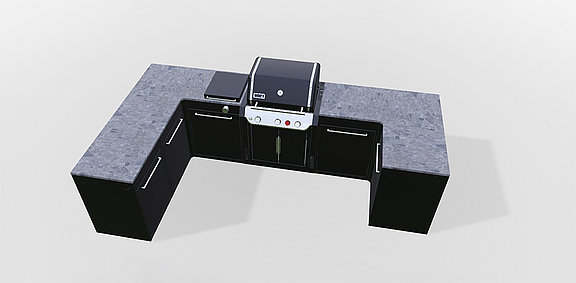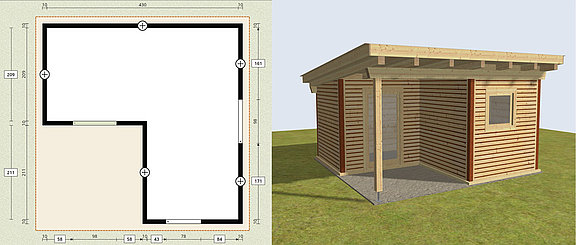2D vs. 3D configurator: Which one is right for me?
Author: Matthias Baumgartner
To make this decision, clear answers to this frequently asked question are needed. In addition to the product itself, other factors also play an important role in this fundamental decision. Who are the users? What product data is available? How important is performance/speed? How high is the number of variants?
Why the choice between 2D and 3D configurator is important
The choice between a 2D and a 3D configurator is of great importance because there are different advantages and disadvantages depending on the product and the target group. Our experience has taught us that it is not advisable to start with a 2D configurator and then switch to 3D. It is important not to compromise here, because the decision between 2D and 3D can have a significant impact on the success of the configurator.
What is a 2D configurator?
A 2D configurator shows you a product in a two-dimensional view. Photos, renderings, drawings, etc. can be used for this view. During the configuration itself (e.g. changing a color), the corresponding 2D data is reloaded and displayed depending on the selection.
What is a 3D configurator?
A 3D configurator shows you a product in a three-dimensional view. A 3D configurator thus offers a spatial representation in which user:inside can view the object from different angles. For this purpose, a web-based 3D model is used for the representation, which is then customized with various options and features in the design, function, size, etc..
Difference 2D configurator vs 3D configurator
Usability
Regardless of whether 2D or 3D, a good configurator should be user-friendly. The display itself has no influence on usability. However, it must be noted that for products with a certain complexity, usability is difficult to implement in a 2D representation.
Visual representation
In a two-dimensional view in the configurator, there is always an area that the users of the configurator do not "see". What is shown can be represented very realistically and in detail in the form of a photo. In the case of a three-dimensional view, an unlimited view of the product is possible thanks to a 3D model. The product can be viewed from all sides. A 3D viewer can also limit the angles of the view (e.g. it makes no sense to view a house from below). In addition, good visual effects can be achieved with camera and lighting settings.
Functionality
Especially with modular products, a 2D representation quickly reaches its limits. If you want to interactively assemble a system in the configurator (example outdoor kitchen in U-shape), a 3D configurator is the first choice.

It is also often a good idea to combine a 2D planning mode with a 3D view.

Shopping experience & customer interaction
In the case of consumer goods, the trend is clearly moving in the direction of 3D presentation. A 3D configurator enhances the customer experience by interacting with the product and thus increases the likelihood of a sale.
Costs
The cost of developing a 2D configurator is usually lower than for a 3D configurator. This is because 2D data is easier and faster to create and requires fewer resources for technical implementation. For the creation of a 3D configurator, a corresponding technical infrastructure, such as the Combeenation platform, is required. In addition, experienced 3D designers and developers must be used to create the 3D models and animations, which incurs further costs. However, a 3D configurator can also offer greater added value for customers by enabling more realistic representations and promoting a better imagination. This can have a positive impact on customer loyalty and sales in the long term. Therefore, the costs for a 3D configurator should be evaluated in terms of the expected added value for the company and the customers.

Product texture
How can the product properties (materials, surfaces) be communicated to the user? In 2D, this can be done very realistically and easily with the help of photos. Customers can see exactly what a material or surface looks like. With 3D this is also possible, but with more effort. Here, too, realistic 3D models can be created and very good results achieved.
Competitive advantage
A 3D representation of your product is nowadays indispensable to (continue to) stand out from competitors. Especially in the consumer goods sector and retail, the choice always falls on a 3D representation.
Augmented Reality
Augmented reality can be easily used with the help of a 3D model. Augmetned reality is only possible with 3D configurators.
Advantages and disadvantages of a 2D configurator
Advantages:
- simple and rapid implementation for products with manageable variants and/or color variety
- often 2D data are already available and can be provided quickly
- photorealistic representation
- no 3D knowledge required
Disadvantages
- no or few interaction possibilities
- if several components can be combined, a lot of individual 2D data is necessary
- with complex products, the limits of the representation are reached in order to make the product tangible for the customer
- for certain product areas (system furniture, cars, shelves, lights,...) a 2D representation is no longer up-to-date or competitive.
Advantages and disadvantages of a 3D configurator
Advantages:
- for products with complex possibilities and many surface variants, the 3D configurator is the most flexible solution
- personalization (selection and display of a desired color) easily possible
- easy maintenance for extensions of colors and surfaces
- interaction possibilities
- animation possibilities
- augmented reality
- increases dwell time
- creates trust
Disadvantages:
- often a service is necessary to create a 3D model
- for complex, detailed products a certain loading time of the data has to be considered
Best Practice Examples
Successful 2D configurator for automation
In this example, the customer was able to create 2D renderings himself. Here, an additional interaction from the 2D data was implemented for the drawers (selection and display of the required sizes) and for the door (open/closed). For this industrial product, the focus is on listing and selecting the technical specification and options.
To the "Configurator for automation solution" case study
Successful 3D configurator - wheels for MTB or road bike
The challenge is that the set of wheels can be assembled from a variety of hubs and rims. In addition, there is the possibility of designing each spoke individually in a specific color. If one were to create two-dimensional data for every possible combination, this would be both very time-consuming and not economical.
To the Case Study "Wheel Configurator"
Conclusion: 2D configurator or 3D configurator?
It is crucial to conduct a thorough analysis of the requirements and goals of the configurator right at the start. In doing so, one should always keep the target group in mind and ask oneself who will use the configurator and what added value it offers to the users. It is important to understand which reasons lead to wanting to use the configurator in the first place. Only on this basis can a comprehensive evaluation of the advantages and disadvantages of 2D and 3D technologies be made in order to make an informed decision on the implementation of a successful configurator.